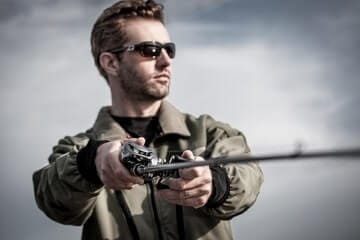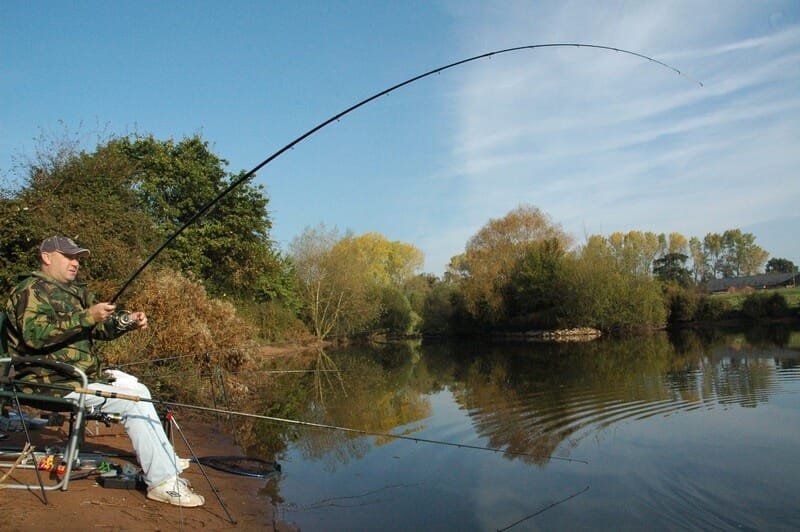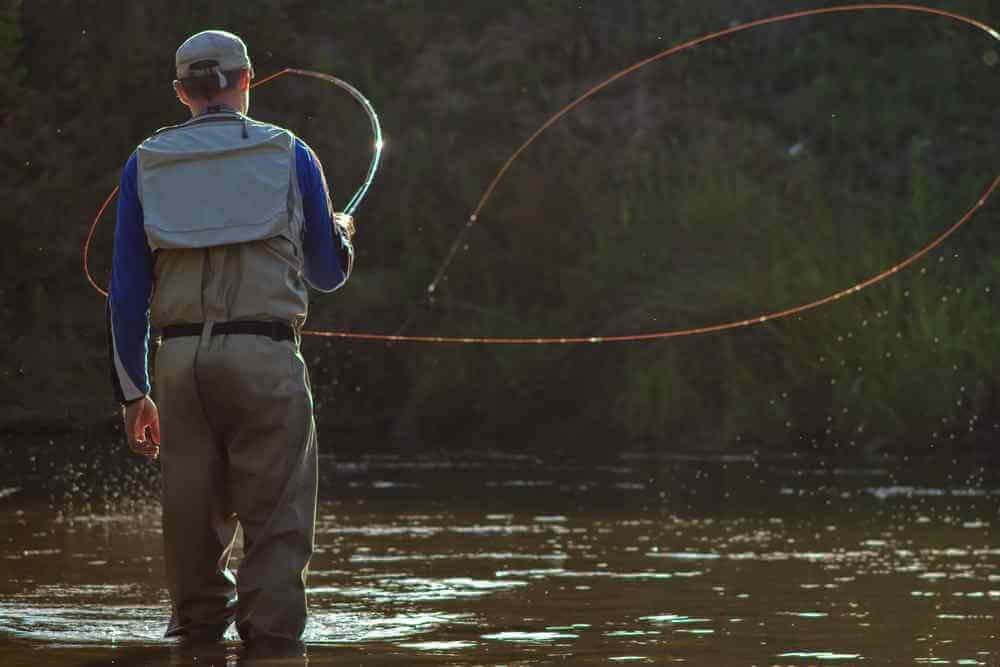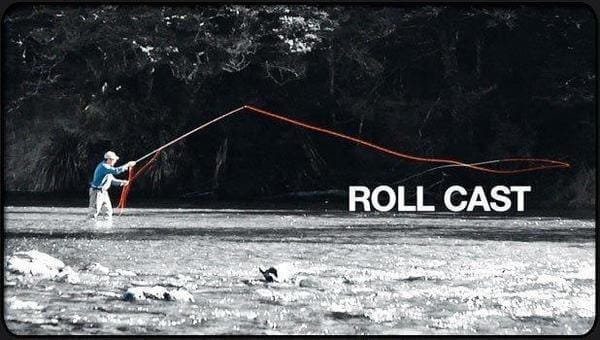Fly fishing is a method of fishing where you use an artificial fly to catch a fish. Since it is a form of fishing, there are subtle differences between fly fishing and other forms of fishing. For instance, The line used to cast while fly fishing is specialized. Also, special kinds of rods and reels are used. The whole fly fishing casting technique in itself also varies much. Today, we’re going to see the casting techniques that can be used to cast while fly fishing.
But before that, let us see what casting is, what it does and what are the factors involved in casting.
What is Casting?

Angling is a method of fishing by using an “angle” or a fish hook. This hook is generally attached to a fishing line and the line to a fishing rod. Modern fishing rod is usually fitted with a fishing reel that acts as a mechanism for retrieving, storing, and paying out the line.
In angling, casting is a process or an act of throwing bait using a fishing line over the water with the help of a flexible rod. Casting can also be used as a term to denote net fishing.
There are many techniques of casting. The most commonly used technique is that the fisherman quickly flicks the rod towards the water. As the technique varies with the form of fishing, there are many ways to go about it. For example, Fly fisherman use lighter rods and lines. They have much knowledge of casting as they use the motion of their hands and arms with greater accuracy to catch the fish. On the other hand, Saltwater anglers use heavy rods and lines. The bait that they use is heavier than the flies.
Steps of Fly Fishing Casting
Fly fishing is the most difficult fishing technique out there. It takes immense patience and hard work to master this technique. The reward, however, is very good. Though the proper way to fly fish mainly varies with people to people. We’ve presented an overall idea to cast while fly fishing. It is in the form of a list and the technique is given below:
Loading
The first step is to load your fly rod. The rod won’t cast properly if it doesn’t seem to bend. You need to have some potential energy into the rod’s flex. You can also let some line out of the fly rod. Letting more line out of the rod adds more load to the rod. If you perform this step correctly, then your cast’s torque(force) with the flex from the rod will enable you to carry even a heavy fly.
Grip
The grip should be strong. Grip the rod like it’s a human hand. The thumb of your finger should be on top and the rest four fingers should wrap the rod. The grip should be strong but it shouldn’t be tight. You need to leave some room for fluidity. A firm but a relaxed grip is the way to do it. If you want more accuracy and less power, then move your hand up the rod, right at the point where the rod bends. Move your hand down the grip and you get increased power. Also, be sure to keep the fly’s butt under your wrist with your forearm to maintain a plane while casting.

Start Casting
Start from the back cast. Begin with your fly line in front of you and cast it back. Input a lot of power into the back cast. This is the most important part of the cast. Start slow and increase the pace as you move your rod back. The stop at the back should be really sturdy. If you back cast properly you won’t have a problem forward casting. As far as the degree of the overhead cast is concerned, everyone has a personal preference.
Some prefer a sidearm cast, some go with the overhead cast while some keep it 45 degrees. Every single one has their own importance. Also, remember to keep your wrist sturdy and your elbow close too. The most crucial thing is that, in both the forward and backward cast, you need the movements to be in a really straight line.
Pause
The next step is to pause once your fly line fully leaves the surface. That is, at the top or the highest peak of your backcast movement, PAUSE! Why? Because it allows the movement of momentum i.em momentum travels all the way down the line. But pause for how much time? Well, that depends. The main thing that it depends on is the amount of line and rod load that you’ve used. The correct amount of time that you need to wait is for the fly line to unfurl behind you almost entirely. The leader is then nearly extended at full, the moment you start to forward cast.
Forward Cast
You need to now finish with the forward cast. From the pause position, begin to cast forward smoothly. Remember! Straight Lines. Cast in a straight line toward the spot where you want to fish. Now, begin moving slowly and speed up if you want to change your spot and fish farther. This movement shouldn’t be uptight. Do it in a relaxed but a swift way. You are again doing this by transferring energy from the movement into the line. Again, the main thing to keep in mind my friend is STRAIGHT LINES. If you don’t keep a straight line, the fly will wander.

Stop
The final step is to stop your hand suddenly with your fly rod’s pointing upwards. The line will continuously transfer the momentum from your movement. You should keep the rod tip upright because it will help the line carry out to its complete distance. Slowly, you will feel the rod unload. When the line is in flight, slightly turn down your thumb and finally, keep your hand stationary and let the line fly out of the rod.
Some Useful Tips For Casting
Your excellence in this whole casting process mainly depends upon how much you’ve practiced. Having said that, there are some useful tips that we can give you to further motivate you and help you get to the expert level fast. These are not the cheat codes to success. They’re just some pointers pointing you towards the right direction.
So let us begin. We’re going to give some pointers in each step.
Loading/Gripping/Casting(forward and backward) tips:
- Get yourself a fly fishing manual with a diagram. Or, study any diagram, maybe a youtube video. Whatever you can find. The point is to visually study how professional fly fishers cast.
- The next tip is to keep your wrist straight and your elbows close to your body. it’s like a dumbbell exercise while you’re working out.
- The pause during the back cast is very important. It is perfectly fine to look back and see your backward cast while you’re practicing.
- Finally, start and finish the cast with the rod tip low and the line straight. Again, I cannot stress how much important the straight line is.
Roll Casting
 A roll cast is used when there is no space behind you for you to backcast. This condition occurs when there are trees, bushes etc behind you. These obstacles limit the movements of your cast. These situations call for a roll cast. Also, roll cast is perfect for practicing your casting as it keeps the line and the fly closer to your body.
A roll cast is used when there is no space behind you for you to backcast. This condition occurs when there are trees, bushes etc behind you. These obstacles limit the movements of your cast. These situations call for a roll cast. Also, roll cast is perfect for practicing your casting as it keeps the line and the fly closer to your body.
Method of Roll Cast
We won’t get into the details but explain the whole roll casting technique in short.
- If you want to practice role cast, the most important thing you need is enough water since the line is to be anchored in water and it must form a D-loop. It should also unroll properly. You also need like 25 feet of line laid out with the tip of the rod pointing at the surface of the water.
- Steadily draw the rod back up and drag the end of the line and leader across the surface of the water. Stop your stroke with the tip of the rod high, just past verticle. At this point, a D-loop should be created with the line slacked and dropping behind the tip.
- Since the D-Loop is formed, the rod must be moved fast forward. Finish the pacing up with a stop. The cast should then be unrolled steadily over the water surface.
Conclusion
Fly fishing is really a great technique to master. The casting technique can seem a bit elaborate but it can be learned. The steps may also look like they have no structure but you’ll get used to it. The main thing is practice. Practice build your muscle memory. Once you have the basics down, your reflex action will start kicking in and you’ll automatically be able to cast a fly fishing rod without much problem. Once you’re done with the fly fishing casting, you can then broaden your skill set and try a different casting technique. We wish you all the best for your upcoming casting endeavors.